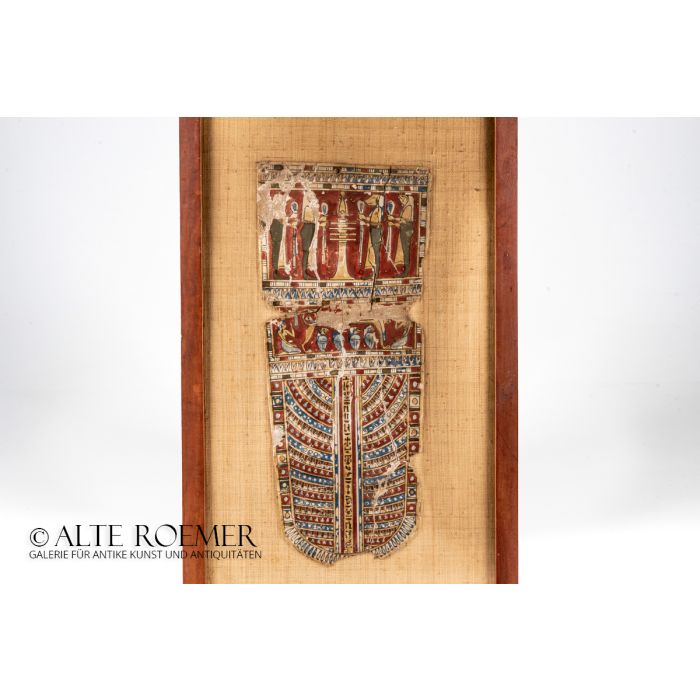Egyptian mummy cartonnage
Price: on request
Sold
Object number
AR3085B
| Object: |
Central piece of a mummy cartonnage
|
| Material: |
Cartonnage made of gessoed and painted pieces of papyri.
|
| Period: |
From Ptolemaic Egypt, 332 BC to 30 BC. |
| Description: |
Central piece of an Egyptian cartonnage mummy trapping. Richly painted in the colours red, blue, green, yellow and black. White areas are represented by the background colour. The piece has three fields with different decorations. The upper field has a red background. The centre boosts an erect djed pillar adorned by the Atef crown of Osiris. To the left and right are the four sons of Horus, Imsety, Duamutef, Hapi and Qebehsenuef. Each holds a strip of fabric in his hands. The djed pillar and the sons of Horus represent the most important inner organs. The scene symbolizes the rebirth of the god Osiris and at the same time the rebirth of the deceased who became an Osiris. The middle field has a red background as well. It shows the mummy of the deceased on a lion shaped stretcher in the centre of the field (mummy not preserved). Four canopic jars are beneath the stretcher, each with a lid in the shape of the heads of the sons of Horus. Isis is kneeling to the left with hands raised in a mourning gesture. Nephthys is depicted to the right in the same gesture. Both of them mourning would cause the resurrection of Osiris and the deceased according to the ancient Egyptian beliefs. The middle and upper field must be interpreted as two different points in time. While the deceased is still dead in the middle field, equipped with all that is needed for resurrection, the upper field shows him or her in a symbolic way as resurrected. The lower field is the largest one. It gives room to 20 decorative bands divided symmetrically by a column of hieroglyphs. The text reads: An offering, given by the king, made for Osiris, the great god, lord of the west (of the realm of the dead), the lord of Abydos, giving an offering for the dead, consisting of beer, bread, cattle and poultry, as well as all the things good and pure, assembled for Osiris, the one living in eternity. The ornaments points to an origin of this cartonnage in Akhmim (also spelled Achmim) in Upper Egypt. |
| Dimensions: |
Cartonnage piece 45cm x 19cm. Modern wooden frame 64.5cm x 38cm.
|
| Condition: |
Fragment with various chips, cracks and missing parts at the borders, especially one larger missing part in the middle where only the substrate is visible. However good overall condition for such a fragile artefact. The original gessoe and paint is still largely preserved on the substrate. The cartonnage fragment is mounted on a modern linen background and framed. The modern wooden frame is beginning to break down being several decades old. A sticker on its rear side informs that it has been made in a workshop in Paris, France.
|
| Provenance: |
Acquired by us in 2020 from S. Goenitzer, Austria. Exported in 2020 with permission of the Austrian Federal Monuments Office. Previously in the possession of Dr. Edmund Kupka, Austria. Acquired together with another mummy cartonnage (our object ID AR3085A) in the 1960ies in Egypt, during his occupation at in international organization in Cairo. Exported to Austria in the 1960ies by Dr. Kupka. The original place of manufacture and certainly also the find spot is given by the long column of hieroglyphic inscription, it is the surrounding of the city of Thebes in Upper Egypt (modern Luxor). |
| References: |
The dating and interpretation of the mummy cartonnage was done in 2020 by Prof. Kurth, emeritus of Egyptology at Hamburg University, Germany. A publication of this cartonnage is planned for his upcoming book „Hausgrabungen, Band 3 (Aegyptiaca in deutschem Privatbesitz)".
|
| Literature: |
For diving deeper into Egyptian funerary literature and cult: Jan Assmann in Lexikon der Aegyptologie, Volume VI, pages 659-676.
|
| Authenticity: |
We unconditionally guarantee the authenticity of every artefact, all items are subject to our lifetime return policy on authenticity.
|


